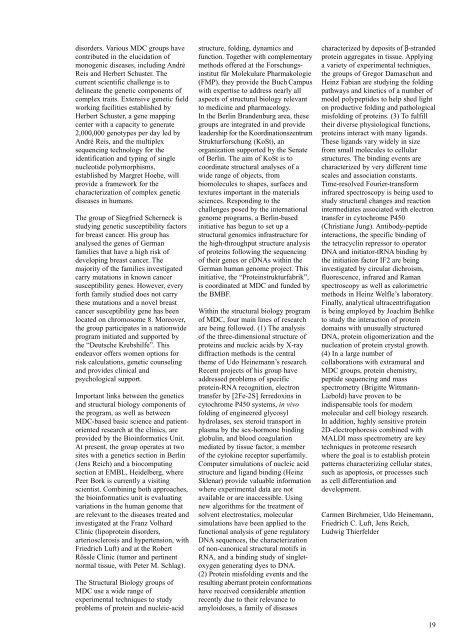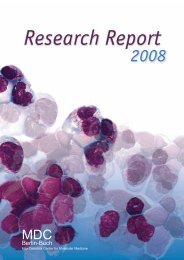Create successful ePaper yourself
Turn your PDF publications into a flip-book with our unique Google optimized e-Paper software.
disorders. Various <strong>MDC</strong> groups have<br />
contributed in the elucidation of<br />
monogenic diseases, including André<br />
Reis and Herbert Schuster. The<br />
current scientific challenge is to<br />
delineate the genetic components of<br />
complex traits. Extensive genetic field<br />
working facilities established by<br />
Herbert Schuster, a gene mapping<br />
center with a capacity to generate<br />
2,000,000 genotypes per day led by<br />
André Reis, and the multiplex<br />
sequencing technology for the<br />
identification and typing of single<br />
nucleotide polymorphisms,<br />
established by Margret Hoehe, will<br />
provide a framework for the<br />
characterization of complex genetic<br />
diseases in humans.<br />
The group of Siegfried Scherneck is<br />
studying genetic susceptibility factors<br />
for breast cancer. His group has<br />
analysed the genes of German<br />
families that have a high risk of<br />
developing breast cancer. The<br />
majority of the families investigated<br />
carry mutations in known cancer<br />
susceptibility genes. However, every<br />
forth family studied does not carry<br />
these mutations and a novel breast<br />
cancer susceptibility gene has been<br />
located on chromosome 8. Moreover,<br />
the group participates in a nationwide<br />
program initiated and supported by<br />
the “Deutsche Krebshilfe”. This<br />
endeavor offers women options for<br />
risk calculations, genetic counseling<br />
and provides clinical and<br />
psychological support.<br />
Important links between the genetics<br />
and structural biology components of<br />
the program, as well as between<br />
<strong>MDC</strong>-based basic science and patientoriented<br />
research at the clinics, are<br />
provided by the Bioinformatics Unit.<br />
At present, the group operates at two<br />
sites with a genetics section in Berlin<br />
(Jens Reich) and a biocomputing<br />
section at EMBL, Heidelberg, where<br />
Peer Bork is currently a visiting<br />
scientist. Combining both approaches,<br />
the bioinformatics unit is evaluating<br />
variations in the human genome that<br />
are relevant to the diseases treated and<br />
investigated at the Franz Volhard<br />
Clinic (lipoprotein disorders,<br />
arteriosclerosis and hypertension, with<br />
Friedrich Luft) and at the Robert<br />
Rössle Clinic (tumor and pertinent<br />
normal tissue, with Peter M. Schlag).<br />
The Structural Biology groups of<br />
<strong>MDC</strong> use a wide range of<br />
experimental techniques to study<br />
problems of protein and nucleic-acid<br />
structure, folding, dynamics and<br />
function. Together with complementary<br />
methods offered at the Forschungsinstitut<br />
für Molekulare Pharmakologie<br />
(FMP), they provide the Buch Campus<br />
with expertise to address nearly all<br />
aspects of structural biology relevant<br />
to medicine and pharmacology.<br />
In the Berlin Brandenburg area, these<br />
groups are integrated in and provide<br />
leadership for the Koordinationszentrum<br />
Strukturforschung (KoSt), an<br />
organization supported by the Senate<br />
of Berlin. The aim of KoSt is to<br />
coordinate structural analyses of a<br />
wide range of objects, from<br />
biomolecules to shapes, surfaces and<br />
textures important in the materials<br />
sciences. Responding to the<br />
challenges posed by the international<br />
genome programs, a Berlin-based<br />
initiative has begun to set up a<br />
structural genomics infrastructure for<br />
the high-throughput structure analysis<br />
of proteins following the sequencing<br />
of their genes or cDNAs within the<br />
German human genome project. This<br />
initiative, the “Proteinstrukturfabrik”,<br />
is coordinated at <strong>MDC</strong> and funded by<br />
the BMBF.<br />
Within the structural biology program<br />
of <strong>MDC</strong>, four main lines of research<br />
are being followed. (1) The analysis<br />
of the three-dimensional structure of<br />
proteins and nucleic acids by X-ray<br />
diffraction methods is the central<br />
theme of Udo Heinemann’s research.<br />
Recent projects of his group have<br />
addressed problems of specific<br />
protein-RNA recognition, electron<br />
transfer by [2Fe-2S] ferredoxins in<br />
cytochrome P450 systems, in vivo<br />
folding of engineered glycosyl<br />
hydrolases, sex steroid transport in<br />
plasma by the sex-hormone binding<br />
globulin, and blood coagulation<br />
mediated by tissue factor, a member<br />
of the cytokine receptor superfamily.<br />
Computer simulations of nucleic acid<br />
structure and ligand binding (Heinz<br />
Sklenar) provide valuable information<br />
where experimental data are not<br />
available or are inaccessible. Using<br />
new algorithms for the treatment of<br />
solvent electrostatics, molecular<br />
simulations have been applied to the<br />
functional analysis of gene regulatory<br />
DNA sequences, the characterization<br />
of non-canonical structural motifs in<br />
RNA, and a binding study of singletoxygen<br />
generating dyes to DNA.<br />
(2) Protein misfolding events and the<br />
resulting aberrant protein conformations<br />
have received considerable attention<br />
recently due to their relevance to<br />
amyloidoses, a family of diseases<br />
characterized by deposits of β-stranded<br />
protein aggregates in tissue. Applying<br />
a variety of experimental techniques,<br />
the groups of Gregor Damaschun and<br />
Heinz Fabian are studying the folding<br />
pathways and kinetics of a number of<br />
model polypeptides to help shed light<br />
on productive folding and pathological<br />
misfolding of proteins. (3) To fulfill<br />
their diverse physiological functions,<br />
proteins interact with many ligands.<br />
These ligands vary widely in size<br />
from small molecules to cellular<br />
structures. The binding events are<br />
characterized by very different time<br />
scales and association constants.<br />
Time-resolved Fourier-transform<br />
infrared spectroscopy is being used to<br />
study structural changes and reaction<br />
intermediates associated with electron<br />
transfer in cytochrome P450<br />
(Christiane Jung). Antibody-peptide<br />
interactions, the specific binding of<br />
the tetracyclin repressor to operator<br />
DNA and initiator-tRNA binding by<br />
the initiation factor IF2 are being<br />
investigated by circular dichroism,<br />
fluorescence, infrared and Raman<br />
spectroscopy as well as calorimetric<br />
methods in Heinz Welfle’s laboratory.<br />
Finally, analytical ultracentrifugation<br />
is being employed by Joachim Behlke<br />
to study the interaction of protein<br />
domains with unusually structured<br />
DNA, protein oligomerization and the<br />
nucleation of protein crystal growth.<br />
(4) In a large number of<br />
collaborations with extramural and<br />
<strong>MDC</strong> groups, protein chemistry,<br />
peptide sequencing and mass<br />
spectrometry (Brigitte Wittmann-<br />
Liebold) have proven to be<br />
indispensable tools for modern<br />
molecular and cell biology research.<br />
In addition, highly sensitive protein<br />
2D-electrophoresis combined with<br />
MALDI mass spectrometry are key<br />
techniques in proteome research<br />
where the goal is to establish protein<br />
patterns characterizing cellular states,<br />
such as apoptosis, or processes such<br />
as cell differentiation and<br />
development.<br />
Carmen Birchmeier, Udo Heinemann,<br />
Friedrich C. Luft, Jens Reich,<br />
Ludwig Thierfelder<br />
19

















